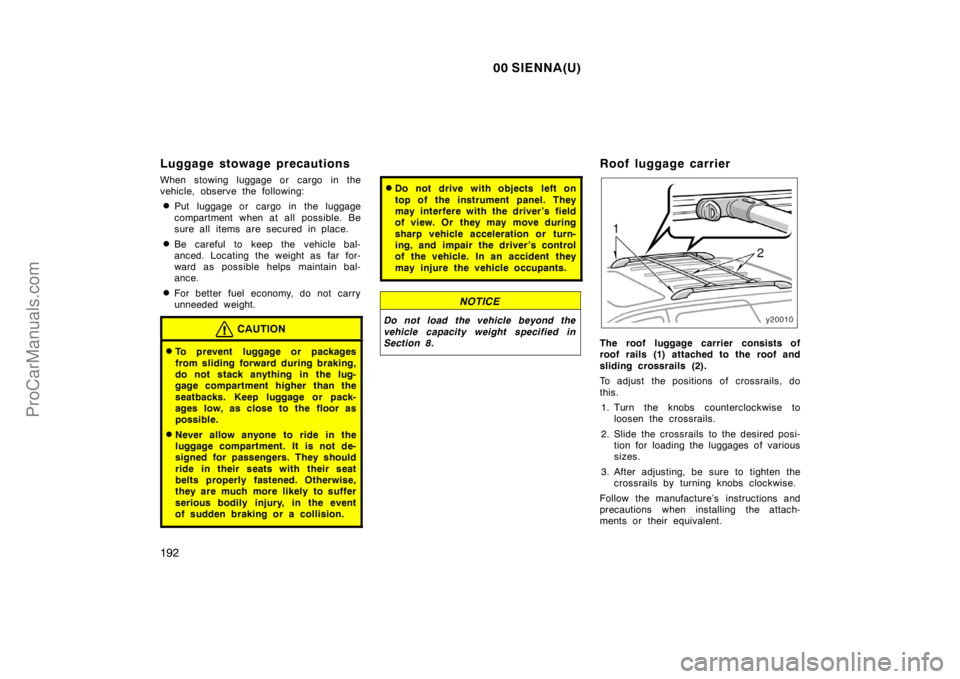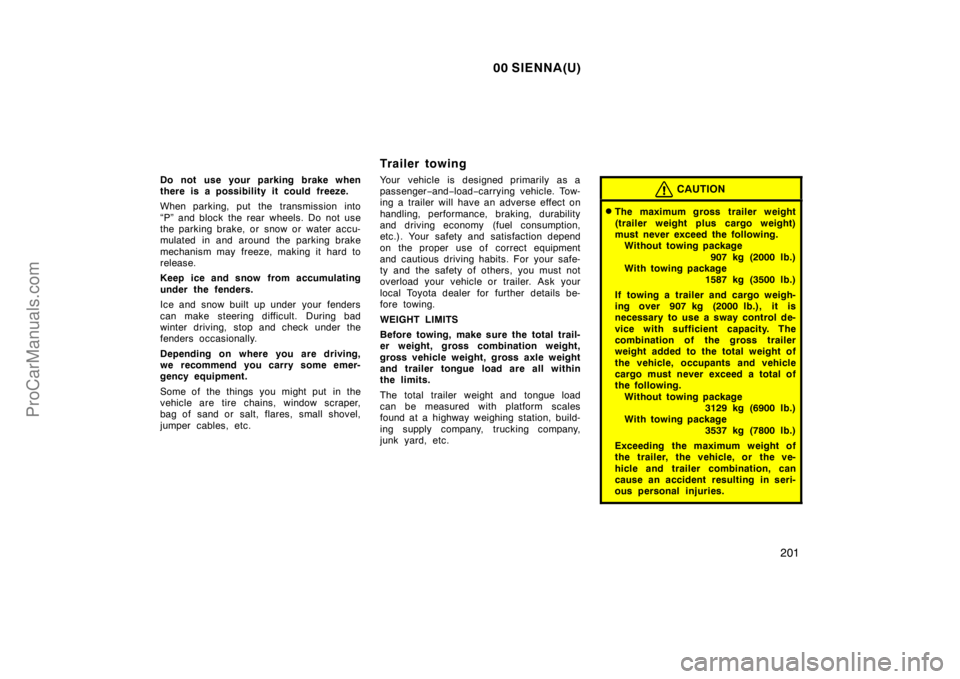Page 198 of 282

00 SIENNA(U)
192
Luggage stowage precautions
When stowing luggage or cargo in the
vehicle, observe the following:
�Put luggage or cargo in the luggage
compartment when at all possible. Be
sure all items are secured in place.
�Be careful to keep the vehicle bal-
anced. Locating the weight as far for-
ward as possible helps maintain bal-
ance.
�For better fuel economy, do not carry
unneeded weight.
CAUTION
�To prevent luggage or packages
from sliding forward during braking,
do not stack anything in the lug-
gage compartment higher than the
seatbacks. Keep luggage or pack-
ages low, as close to the floor as
possible.
�Never allow anyone to ride in the
luggage compartment. It is not de-
signed for passengers. They should
ride in their seats with their seat
belts properly fastened. Otherwise,
they are much more likely to suffer
serious bodily injury, in the event
of sudden braking or a collision.
�Do not drive with objects left on
top of the instrument panel. They
may interfere with the driver’s field
of view. Or they may move during
sharp vehicle acceleration or turn-
ing, and impair the driver’s control
of the vehicle. In an accident they
may injure the vehicle occupants.
NOTICE
Do not load the vehicle beyond the
vehicle capacity weight specified in
Section 8.
Roof luggage carrier
The roof luggage carrier consists of
roof rails (1) attached to the roof and
sliding crossrails (2).
To adjust the positions of crossrails, do
this.
1. Turn the knobs counterclockwise to
loosen the crossrails.
2. Slide the crossrails to the desired posi-
tion for loading the luggages of various
sizes.
3. After adjusting, be sure to tighten the
crossrails by turning knobs clockwise.
Follow the manufacture’s instructions and
precautions when installing the attach-
ments or their equivalent.
ProCarManuals.com
Page 207 of 282

00 SIENNA(U)
201
Do not use your parking brake when
there is a possibility it could freeze.
When parking, put the transmission into
“P” and block the rear wheels. Do not use
the parking brake, or snow or water accu-
mulated in and around the parking brake
mechanism may freeze, making it hard to
release.
Keep ice and snow from accumulating
under the fenders.
Ice and snow built up under your fenders
can make steering difficult. During bad
winter driving, stop and check under the
fenders occasionally.
Depending on where you are driving,
we recommend you carry some emer-
gency equipment.
Some of the things you might put in the
vehicle are tire chains, window scraper,
bag of sand or salt, flares, small shovel,
jumper cables, etc.
Trailer towing
Your vehicle is designed primarily as a
passenger−and−load−carrying vehicle. Tow-
ing a trailer will have an adverse effect on
handling, performance, braking, durability
and driving economy (fuel consumption,
etc.). Your safety and satisfaction depend
on the proper use of correct equipment
and cautious driving habits. For your safe-
ty and the safety of others, you must not
overload your vehicle or trailer. Ask your
local Toyota dealer for further details be-
fore towing.
WEIGHT LIMITS
Before towing, make sure the total trail-
er weight, gross combination weight,
gross vehicle weight, gross axle weight
and trailer tongue load are all within
the limits.
The total trailer weight and tongue load
can be measured with platform scales
found at a highway weighing station, build-
ing supply company, trucking company,
junk yard, etc.CAUTION
�The maximum gross trailer weight
(trailer weight plus cargo weight)
must never exceed the following.
Without towing package
907 kg (2000 lb.)
With towing package
1587 kg (3500 lb.)
If towing a trailer and cargo weigh-
ing over 907 kg (2000 lb.), it is
necessary to use a sway control de-
vice with sufficient capacity. The
combination of the gross trailer
weight added to the total weight of
the vehicle, occupants and vehicle
cargo must never exceed a total of
the following.
Without towing package
3129 kg (6900 lb.)
With towing package
3537 kg (7800 lb.)
Exceeding the maximum weight of
the trailer, the vehicle, or the ve-
hicle and trailer combination, can
cause an accident resulting in seri-
ous personal injuries.
ProCarManuals.com
Page 275 of 282
00 SIENNA(U)
269
Tires
Tire sizeTire pressure,
kPa (kgf/cm2 or bar, psi)Wheel size
P205/70R15 95S 240 (2.4, 35) 15�6.5JJ
220 (2.2, 32)
∗
1
240 (2.4, 35)∗
2
T145/80D16 420 (4.2, 60)
15�6.5JJ
16�4T P215/65R15 95S Normal driving
Trailer towing
Tire sizeTire pressure,
kPa (kgf/cm
2 or bar, psi)Wheel size
P205/70R15 95S 240 (2.4, 35) 15�6.5JJ
240 (2.4, 35)
15�6.5JJ P215/65R15 95S
When driving under the above vehicle load conditions at sustained high
speeds above 160 km/h (100 mph), in countries where such speeds are
permitted by−law, inflate the front and rear tires to 240 kPa (2.4 kgf/cm
2
or bar, 35 psi) provided that it does not exceed the maximum cold tire
pressure molded on the tire sidewall. Tire size and pressure:
∗
1: Vehicle load up to 6 passengers∗
2: Up to vehicle capacity weightWheel nut torque, N·m (kgf·m, ft·lbf):
104 (10.5, 77)
ProCarManuals.com